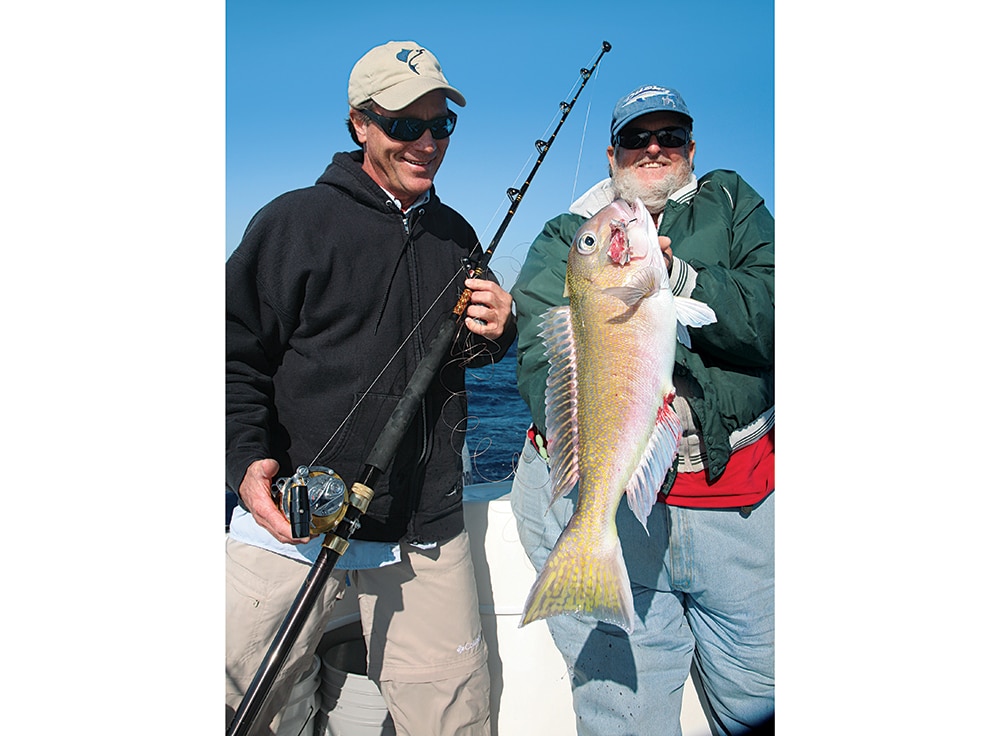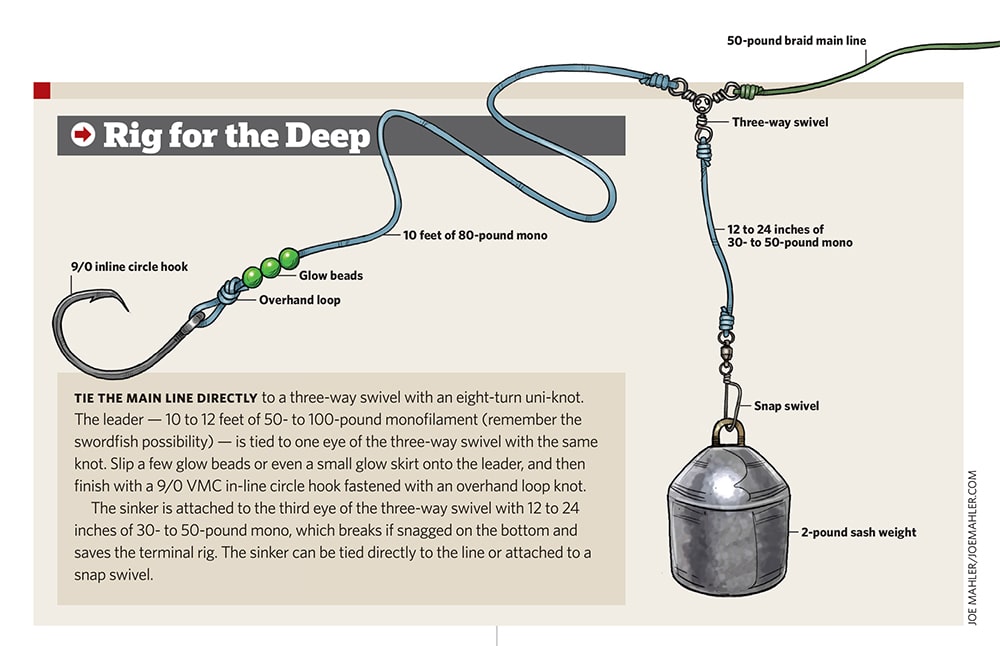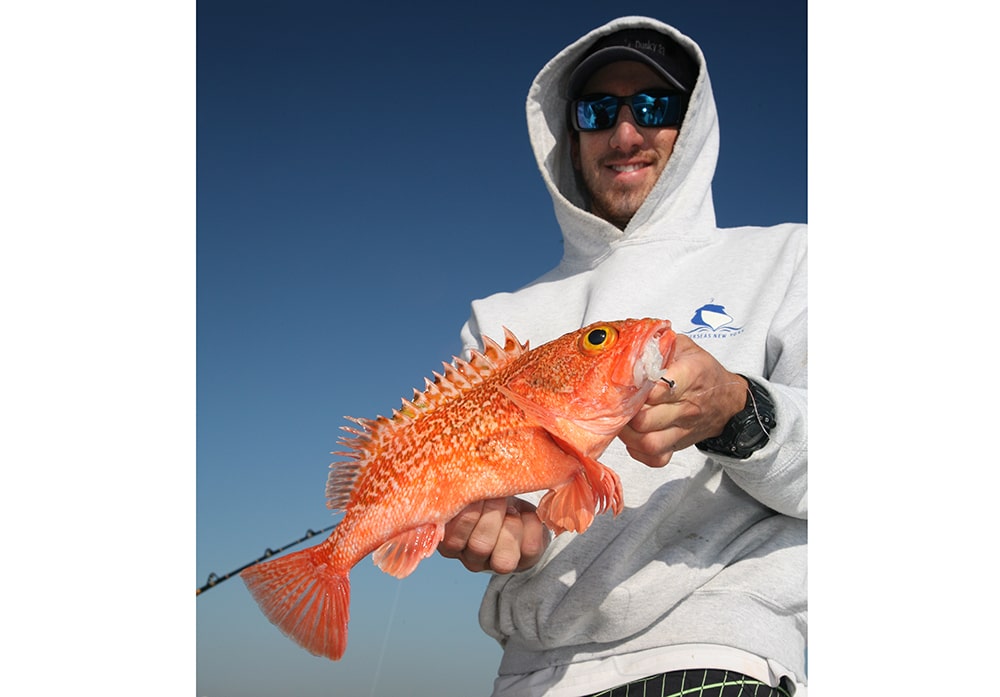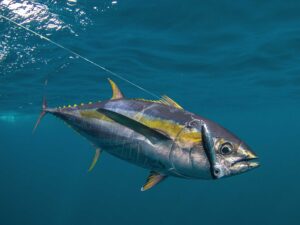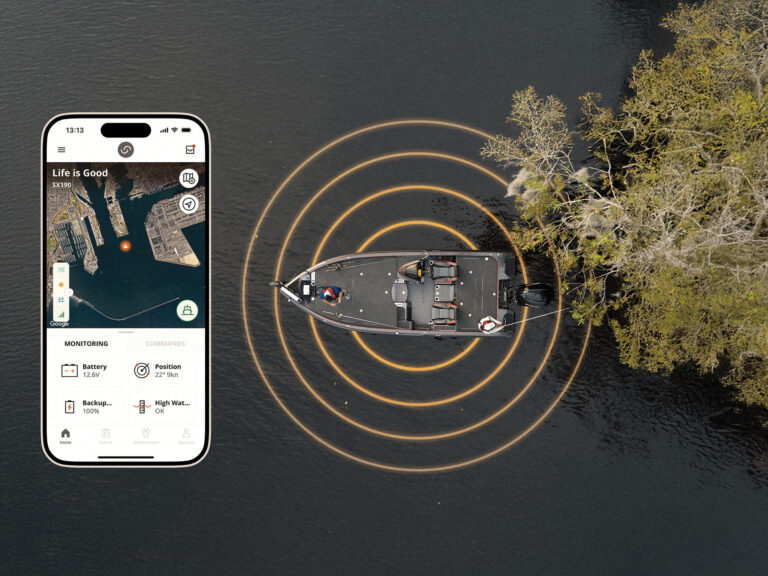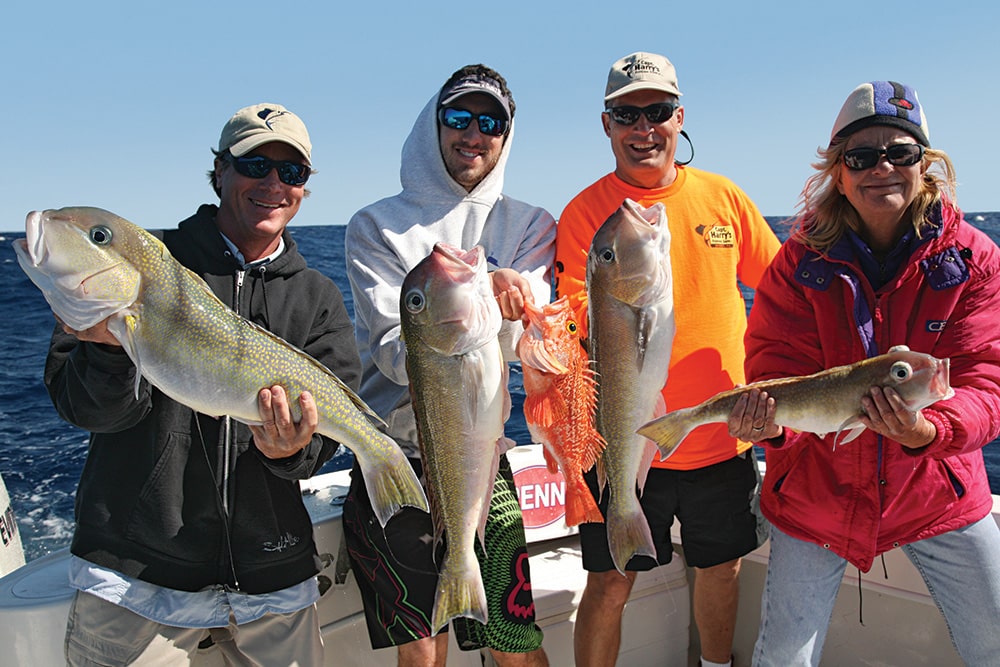
[Be sure to click through all the images in the gallery above.]
Deep Rewards: The waters off Miami, Florida, have a vast network of natural and artificial reefs, one of the best in the world. These reefs attract bait and predator species, providing excellent bottomfishing, which attracts pelagics as well. But a little farther offshore lies a fishery that only a select few, knowledgeable captains take advantage of: the tilefish fishery. Tilefish typically make their homes in 600 feet of water or more. This highly productive fishery is just another in a long list of outstanding opportunities found right in the shadow of one of America’s largest urban areas, only minutes from downtown Miami. And of all the skippers who can find them, no one knows Miami bottomfishing better than Capt. Bouncer Smith.
Something ate the finely tailored, 2-by-2-inch chunk of bonito on the soft bottom 690 feet below, pulling Sue Cocking’s rod tip seaward. On Capt. Bouncer Smith’s advice, Cocking left the rod in its gunwale holder, and hand-cranked the line. The rest of us offered encouragement.
In what seemed like an eternity, but was closer to 10 minutes, a beautiful golden tilefish popped to the surface. That fish, added to the one each Carl Grassi, Harry Vernon III and I caught, made our limit. We headed back to Miami Beach Marina, after a trip barely more than two hours long. The South Beach tilefish bite can be that good.
Southern Range
Smith has been perfecting the know-how and tactics to capitalize on yet another species for South Florida anglers: golden tilefish. And Smith, naturally, is promoting the sporting aspect of it: read “no electric reels!” This is down-and-dirty, hand-crank fishing. But, the reward is outstanding table fare, a fish that many believe tastes a hint like lobster.
Catching golden tilefish off South Florida appears to be a year-round deal, but Smith says winter through spring seems best. “Any time we want to catch a tilefish, we do, regardless of the month,” he says.“We’re fairly new to this right now, so we’re still learning as we go, but we’re proving them to be willing strikers of vertical jigs, except when they’re not biting well. When that’s the case, we get them on chunks of bonito and king mackerel, and also ballyhoo plugs and squid, though ballyhoo and squid don’t stay on the hook as well as bonito and kingfish.”
Compared with the monster golden tilefish caught off the mid-Atlantic and Northeast coasts, those off South Florida are small. Down there, they’ll average around 10 pounds, with a few in the mid-teens. Smith’s largest weigh up to 16 pounds. He reasons the fish there are at their southernmost range, and the Continental Shelf is narrow compared with its vastness off the mid-Atlantic and Northeast. In the limited bottom real estate in South Florida, there is less habitat to support large populations and heftier specimens.
Hello Mud
Smith says success is less about specific spots and more about covering the right type of bottom. He looks for soft bottom between 580 and 720 feet of water, and drifts through these zones. He acknowledges that some rather large goldens come off Fort Lauderdale in depths approaching 900 feet.
Golden tiles are burrowers, residing in holes in soft bottom with their heads peering out. When food sweeps past their holes, they ambush it. Best conditions include a 2-knot current, which enables baits to soak longer along specific pieces of bottom. And, of course, if you hook up, save those coordinates. Smith plots zones where he has done well on his chart recorder, and often sets up drifts through these areas. “Recently, I caught two big goldens within 100 yards of each other on spots that had produced before,” he says. “But covering ground is a must for locating productive bottom. I’ll start in 650 feet, and if none bite, move to 680 feet, and then keep going a bit deeper, or shallower, until we get bit. Not long ago, we had a good bite in 640 feet of water that lasted nearly a month.”
Use Enough Rod
We were using Penn International 50 reels, spooled with 50- and 80-pound braid, and matching stand-up rods. You can go lighter, such as 20-pound braid, when jigging for these fish, but a stout rod best handles the weights necessary to reach bottom and fish vertically; we were using a 2-pound sash weight that morning.
Smith reasons that a few swordfish have been hooked on tilefish rigs, and it’s only a matter of time before a swordfish or big grouper picks off one of these baits. With heavy outfits, he stands a good chance of beating them.
We fished two rods, and experimented with two different-size bonito chunks. The 11⁄4-by-11⁄4-inch chunk was the small bait, with the 2-by-2-inch chunk the large one. These fish have a large mouth, and it goes back to the big-bait/big-fish theory. One of Smith’s biggest golden tiles, a 15-pounder, ate a Spanish mackerel bait intended for sharks.
Given the darkness at these depths, glow beads or skirts illuminate the bait, and attract fish. Smith has been experimenting with a small strobe light on the leader with success; on this outing, this rig scored a blackbelly rosefish and a golden tile. In addition, he’s been adding rattles up by the sinker, and believes the combination of illumination and sound offer a potent advantage.
Play By the Rules
Federal Law allows just one golden tilefish per person per day. Therefore, if you go, bring a few friends to make it worthwhile. Since this fishing occurs over deep water, free-line a live bait or even a fresh ballyhoo while you drift: Dolphin, tuna, sailfish and even the occasional blue marlin have been known to pick off these baits.
Fishing for golden tiles off South Florida is a breeze; long runs aren’t required like they are off the mid-Atlantic and Northeast; and the fish are here. What’s more, if you don’t feel like fighting for your dinner standing up, enjoy fighting the fish out of the gunwale rod holder.
This is fun fishing, requiring just a bit of elbow grease to crank in these fish. When they’re feeding, you can knock off a dinner limit in no time, and then go off hunting for other fish. That’s what tilin’ off South Florida is all about! And it’s all good.
Deepwater Releases
Releasing unwanted or closed-season fish from deep water can be challenging, as they might be suffering from barotrauma (rapid decompression). The SeaQualizer improves the safe release of deepwater fishes. The pressure-activated device works by taking a fish back down into the depths, where it recompresses. The unit is set to release fish at three different depth settings: 50, 100 and 150 feet. It is proving to be a more effective means of releasing bottomfish than venting. For more information, go to saltwatersportsman.com/seaqualizer.
South Florida Golden Tilefish Tackle Box and Planner
Rods: 50-pound-class stand-up rods
Reels: Conventional reels, such as the Penn 50 International
Lines: Braid, 50- to 80-pound-test
Terminal gear: 10 to 12 feet of 50- to 100-pound mono, three-way swivel, 2-pound sash weight sinker, 9/0 VMC in-line circle hook, glow beads, glow skirt, rattles
Bait: Chunks of bonito, king mackerel, ballyhoo plugs, squid
When: Year-round, but best winter through spring
Where: Miami Beach, Florida
Who: Capt. Bouncer Smith, 305-439-2475
Capt. Bouncer Smith is pioneering this fishery, but it’s also available to anyone with a suitable boat, if you choose to blaze the trail on your own. The following local ramps provide easy access to the golden tilefish grounds:
